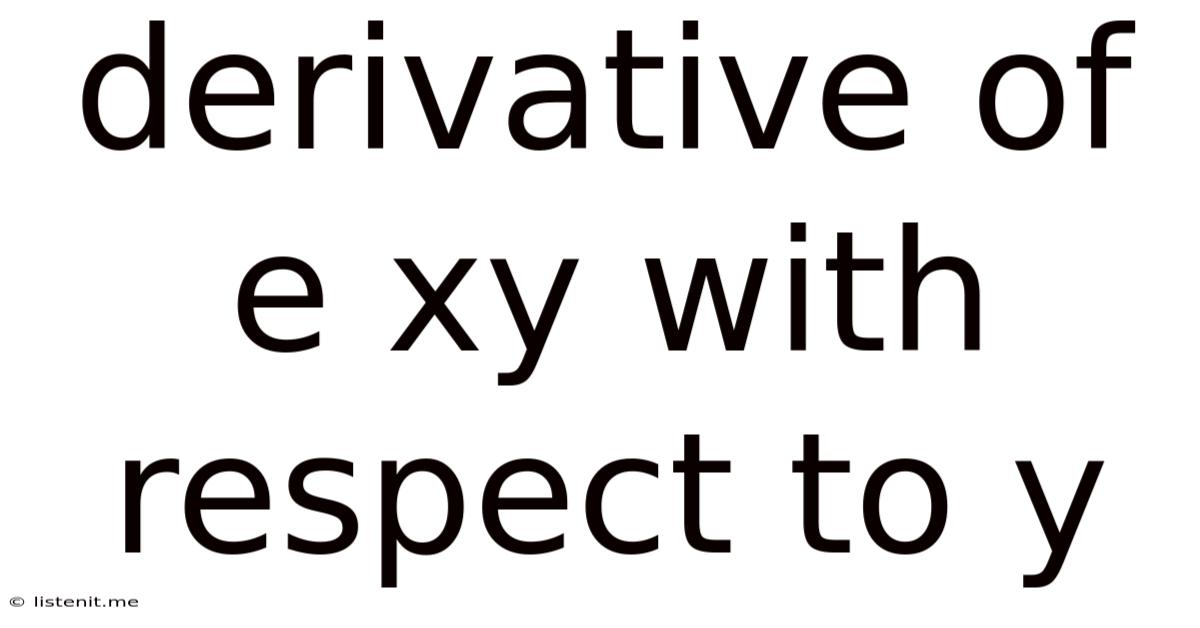Derivative Of E Xy With Respect To Y
listenit
May 12, 2025 · 5 min read

Table of Contents
Finding the Derivative of e<sup>xy</sup> with Respect to y: A Comprehensive Guide
Finding the derivative of a function is a fundamental concept in calculus. This guide delves into the process of calculating the partial derivative of e<sup>xy</sup> with respect to y, explaining the underlying principles and providing a step-by-step approach. We'll explore different methods and consider various scenarios, ensuring a thorough understanding for students and professionals alike.
Understanding the Fundamentals
Before diving into the derivation, let's refresh our understanding of some crucial concepts:
1. Partial Derivatives
A partial derivative measures the rate of change of a multivariable function with respect to one of its variables, while holding the other variables constant. This is crucial when dealing with functions like e<sup>xy</sup>, which depends on both x and y. We'll be focusing on the partial derivative with respect to y, denoted as ∂/∂y.
2. The Chain Rule
The chain rule is essential when differentiating composite functions. It states that the derivative of a composite function is the derivative of the outer function (with the inside function left alone) times the derivative of the inside function. This rule will be instrumental in our derivation.
3. The Exponential Function
The exponential function, e<sup>u</sup>, has a unique property: its derivative is itself (d/du(e<sup>u</sup>) = e<sup>u</sup>). This property simplifies many derivations involving exponential functions.
Deriving ∂/∂y (e<sup>xy</sup>)
Now, let's tackle the main task: finding the partial derivative of e<sup>xy</sup> with respect to y. We'll employ the chain rule, recognizing that e<sup>xy</sup> is a composite function where the outer function is e<sup>u</sup> and the inner function is u = xy.
Step 1: Applying the Chain Rule
According to the chain rule:
∂/∂y (e<sup>xy</sup>) = (∂/∂u (e<sup>u</sup>)) * (∂/∂y (xy))
Step 2: Differentiating the Outer Function
The derivative of the outer function, e<sup>u</sup>, with respect to u is simply e<sup>u</sup>.
Step 3: Differentiating the Inner Function
The derivative of the inner function, xy, with respect to y, treating x as a constant, is x.
Step 4: Combining the Results
Substituting the results from steps 2 and 3 back into the chain rule equation, we get:
∂/∂y (e<sup>xy</sup>) = e<sup>u</sup> * x
Step 5: Substituting Back u
Since u = xy, we can substitute this back into the equation:
∂/∂y (e<sup>xy</sup>) = x * e<sup>xy</sup>
Therefore, the partial derivative of e<sup>xy</sup> with respect to y is xe<sup>xy</sup>.
Exploring Different Approaches and Applications
While the chain rule provides the most straightforward approach, let's examine alternative perspectives and practical applications:
1. Logarithmic Differentiation
For functions involving products and powers, logarithmic differentiation can simplify the process. Let's apply this technique:
Step 1: Take the natural logarithm of both sides.
Let z = e<sup>xy</sup>. Then ln(z) = xy
Step 2: Differentiate both sides implicitly with respect to y.
Remember to use the product rule on the right-hand side:
d/dy(ln(z)) = d/dy(xy)
(1/z) * (dz/dy) = x
Step 3: Solve for dz/dy.
dz/dy = xz
Step 4: Substitute back z = e<sup>xy</sup>
dz/dy = x * e<sup>xy</sup>
This confirms our previous result: the partial derivative of e<sup>xy</sup> with respect to y is xe<sup>xy</sup>.
2. Applications in Multivariable Calculus
This derivative frequently appears in various applications of multivariable calculus, including:
- Optimization Problems: Finding maxima and minima of functions with multiple variables often involves setting partial derivatives to zero. Understanding the derivative of e<sup>xy</sup> is crucial in solving such problems.
- Gradient Vectors: The gradient vector of a function points in the direction of the steepest ascent. The partial derivative with respect to y contributes to the y-component of the gradient vector for the function e<sup>xy</sup>.
- Directional Derivatives: Determining the rate of change of a function in a specific direction involves calculating directional derivatives, which utilize partial derivatives.
- Partial Differential Equations: Partial differential equations model various phenomena in physics, engineering, and other fields. Derivatives like ∂/∂y (e<sup>xy</sup>) might appear in the equations themselves or their solutions.
3. Handling More Complex Scenarios
The principles outlined here extend to more intricate functions. For instance, consider a function like:
f(x, y) = e<sup>x²y + sin(y)</sup>
To find ∂f/∂y, we would again apply the chain rule, remembering that the derivative of the exponential function remains itself, while the derivative of the exponent must be carefully calculated using the sum rule and the chain rule where needed.
Conclusion: Mastering the Derivative of e<sup>xy</sup>
Calculating the partial derivative of e<sup>xy</sup> with respect to y is a fundamental exercise that reinforces the understanding of partial differentiation and the chain rule. Through both direct application of the chain rule and the alternative approach of logarithmic differentiation, we’ve confirmed that the result is xe<sup>xy</sup>. This knowledge forms a building block for tackling more complex problems in multivariable calculus and its various applications across numerous scientific and engineering disciplines. A solid grasp of this derivative is essential for anyone pursuing advanced studies in mathematics, physics, engineering, economics, and other fields that rely heavily on calculus. Remember to practice various examples to solidify your understanding and to build your problem-solving skills.
Latest Posts
Latest Posts
-
Fractions That Are Equivalent To 3 4
May 12, 2025
-
In Dna Fingerprinting What Do Restriction Enzymes Do
May 12, 2025
-
All Square Roots Are Irrational Numbers
May 12, 2025
-
Give The Name For The Following Compounds
May 12, 2025
-
Why Were Immigrants Important To Political Machines
May 12, 2025
Related Post
Thank you for visiting our website which covers about Derivative Of E Xy With Respect To Y . We hope the information provided has been useful to you. Feel free to contact us if you have any questions or need further assistance. See you next time and don't miss to bookmark.